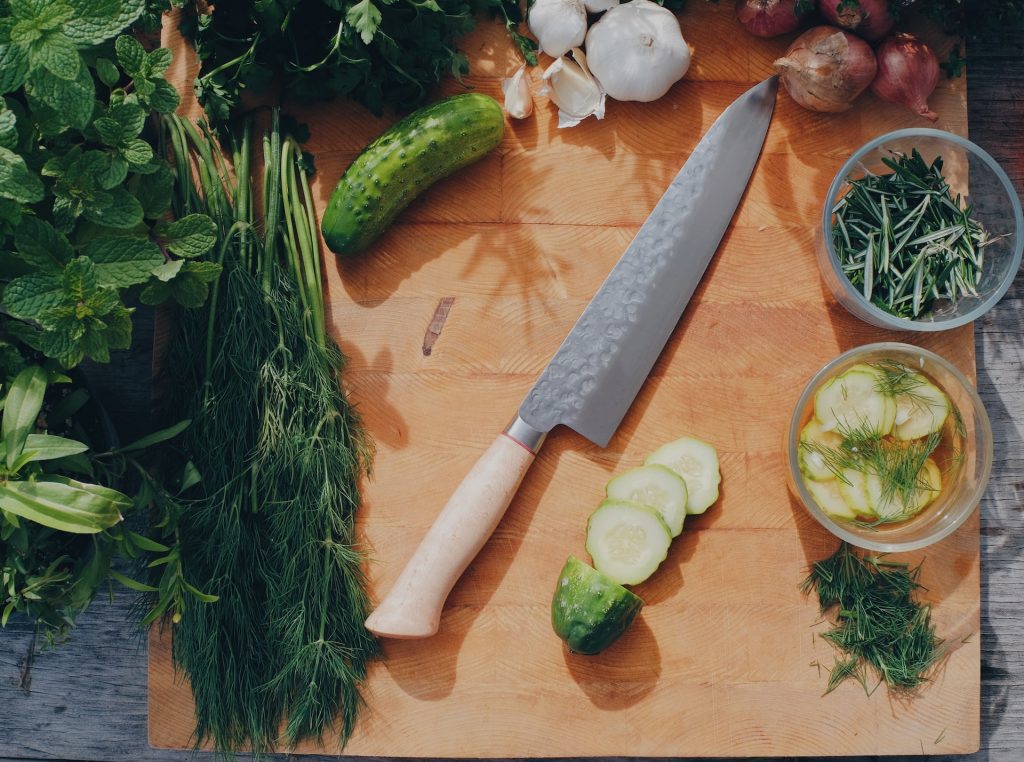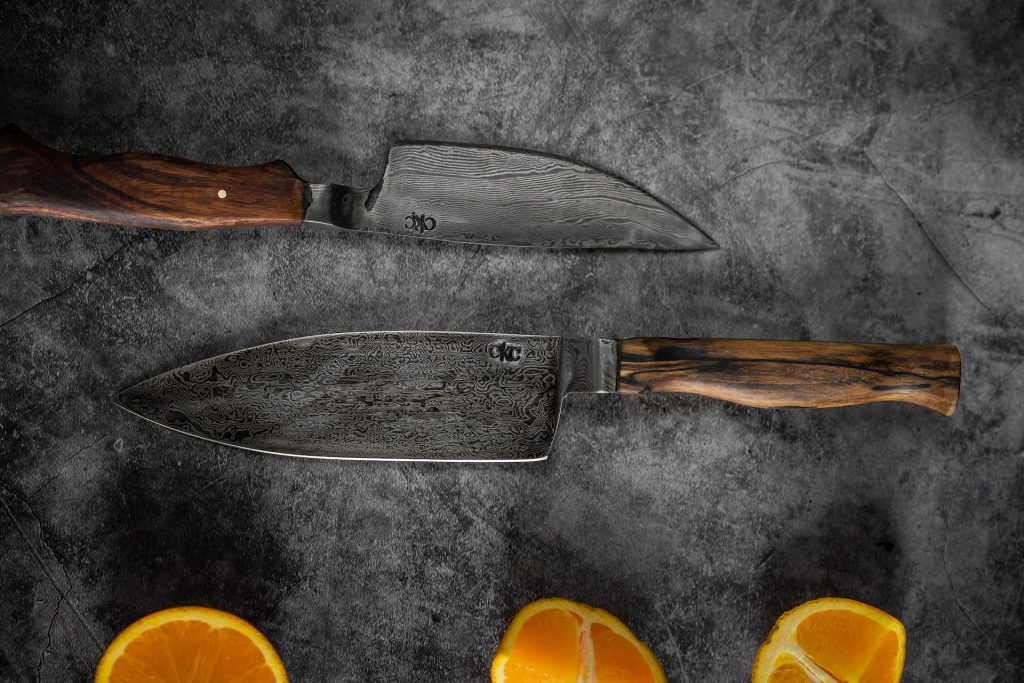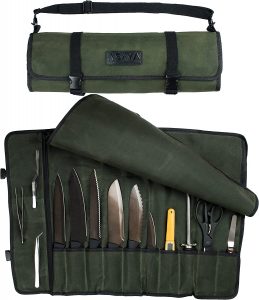How often should knives be sharpened? You probably only think about sharpening your knives once they become unusable. Because you rely on them so much, keeping them well-sharpened is important. But how often should you sharpen your knives?
The answer to this question depends on the type of knife you have and how often you use it, but in general, it should be every 2 weeks. Let’s explore the factors that affect how often you should sharpen your knives.
How to Tell if a Knife Is Too Dull to Be Sharpened

At some point, every knife will become too dull to be effective. Whether you use your knives daily or only for occasional cooking, there will come a time when they need to be sharpened. But how do you know when a knife is too dull to be sharpened? Here are a few ways to tell if a knife is too dull to be sharpened:
➠The Knife Doesn’t Cut Easily Through Food
A knife that doesn’t easily cut through food is a sure sign that it’s too dull to be sharpened. If you find yourself having to see back and forth to make even the simplest cuts, it’s time to get your knives professionally sharpened or invest in a good knife sharpening stone.
➠The Knife Leaves Jagged Edges
If your knife leaves jagged or uneven edges, it’s also too dull to be sharpened. When you sharpen a knife, the blade should be able to create a smooth, clean cut. If the blade is too dull, it will leave behind ragged edges that can make cutting difficult and unsafe.
➠The Knife Requires A Lot Of Pressure To Cut
Another sign that a knife is too dull to be sharpened is if you have to apply a lot of pressure to make it cut. This is not only dangerous, but it can also damage the blade.
➠The Blade Looks Dull and Has a Cloudy Finish
If the blade looks dull and has a cloudy finish, it’s time to sharpen your knife. A dull blade will be difficult to use and dangerous if you attempt to use it without sharpening knives first.
These are the main signs that it’s time to sharpen your knife. So keep this in mind to determine when it’s time to sharpen your knife.
How Often Should Knives Be Sharpened?

A knife that is sharp is a safe knife. That’s why it’s important to keep your knives in good condition by regularly sharpening them. But how often should you sharpen your knives? The answer is more complex than you might think. How often you should sharpen your knives based on three factors: frequency of use, type of knife, and whether or not the knife is serrated.
✔️Frequency of Use
If you are using your knives daily, you will need to sharpen them more frequently than someone who only uses their knives once or twice a week. We recommend sharpening your knives every two weeks if you are using them on a daily basis. If you are only using your knives once or twice a week, you can get away with sharpening them once a month. Of course, this is just a general guideline—if you notice that your knives are starting to feel dull before the two-week or one-month mark, don’t be afraid to sharpen them more frequently. Better safe than sorry!
✔️Type of Knife
The type of knife you use will also affect how often you need to sharpen it. For example, carbon steel knives need to be sharpened more frequently than stainless steel knives because they are more prone to corrosion. If you are using carbon steel knives, we recommend sharpening them every week or two. For stainless steel knives, every two weeks or a month should suffice.
✔️Serrated vs. Non-Serrated Knives
Last but not least, the type of edge on your knife—serrated or non-serrated—will also play a role in how often you need to sharpen it. Serrated knives, which have a saw-like edge, keep sharp for longer than non-serrated knives but are also more difficult to sharpen. We recommend taking your serrated knives to a professional for sharpening at least once a year; if you try to sharpen them yourself, you risk damaging the blade. For non-serrated blades, we recommend sharpening them every two weeks or so with a honing rod or stone
.
As a general rule of thumb, we recommend sharpening your knives every two weeks if you are using them daily—but there are exceptions to this rule based on the type of knife and edge you have. Use this guide as a starting point and adjust accordingly based on how often you use your knives and how quickly they seem to lose their edge. And when in doubt, err on the side of caution and sharpen your knives more frequently rather than less!
The Different Ways to Sharpen a Knife
Now that you know how often you should sharpen your knives let’s talk about the different ways to do it. There are a few different methods for sharpening a knife, each with pros and cons. The three most common ways to sharpen a knife are:
🔪Diamond Stone/Whetstone
A diamond stone or whetstone is the most common way to sharpen a knife at home. Simply put, the stone is rubbed against the knife’s blade to sharpen it. Many home cooks prefer this method because it is relatively inexpensive and easy to do. However, it does require some practice to get the hang of it, and it is essential to avoid over-sharpening your knives. If you decide to go this route, we recommend investing in a medium-grit and a fine-grit stone to produce a consistent edge on your knives.
🔪Electric Sharpeners
Electric sharpeners are the quickest and easiest way to sharpen a knife. All you have to do is run your knives through the machine and they come out razor-sharp! However, electric sharpeners can be expensive, and they tend to wear down blades faster than other methods. If you decide to go this route, we recommend doing some research beforehand to find a quality machine that won’t wear down your knives too fast.
🔪Honing Rod
Honing rod is another popular option for sharpening a knife. This method involves running the knife’s blade against the rod to produce a sharper edge. The advantage of this method is that it requires less practice than using a diamond stone and can be done more quickly. However, it produces a less sharp edge than a diamond stone or whetstone. More details about honing will be discussed below.
🔪Coffee Mug
Believe it or not, you can actually use a coffee mug to sharpen your knives! This method works by running the blade of your knife along the inside lip of the mug several times. While this method is quick and easy, it should only be used as a last resort as it can damage your knives if not done carefully.
🔪Sharpening Services
If you don’t feel comfortable sharpening your own knives or if you have serrated blades, then taking them to a professional sharpening service is probably the best bet. Professional sharpeners can hone your knives and bring them back to like-new condition. While this will cost you money, it is usually worth the investment as a dull knife can be dangerous to use.
These three methods are easy ways to sharpen your knives at home without any special equipment or training. Just be sure to follow our instructions carefully, so you don’t accidentally cut yourself!
Safety Precaution When Sharpening a Dull Knife
- It’s important to take safety precautions when sharpening dull knives.
- Always use a cutting board or similar surface to protect your countertops or tables.
- Make sure the area around you is clear of any potential hazards.
- Steady the knife with your non-dominant hand while you sharpen it with your other hand.
- Use a sharpening stone or steel to quickly and evenly sharpen the blade.
- Avoid touching the blade with your fingers after you’ve sharpened it. And finally, always
wash and dry the knife before storing it.
Following these simple steps can help ensure a safe and effective sharpening experience.
The Difference Between Sharpening and Honing a Blade
For many people, the terms “sharpening” and “honing” are used interchangeably. However, there is a big difference between the two processes. In short, sharpening grinds away metal to create a new edge while honing realigns the existing edge. Here’s a more detailed look at each process:
📌Sharpening
Sharpening involves using abrasive materials (like sandpaper or diamond sharpening stones) to grind away metal from the blade. This process forms a new, sharp edge. While effective, sharpening can also shorten the lifespan of your knives since it removes metal each time it’s done. As such, it should only be used when absolutely necessary—typically, when your knife is so dull that it can’t be honed any longer.
📌Honing
Honing is a less aggressive way to keep your blades sharp. This process relies on a honing rod (sometimes called honing steel) to realign the existing edge of the blade. When done correctly, honing doesn’t remove any metal from the blade. Instead, it simply straightens out any small bends or nicks that have formed over time. It keeps the blade sharper for longer and helps it last longer overall. For these reasons, honing should be done on a regular basis—ideally, every time you use your knives.
By sharpening your knives only when necessary and regularly honing them in between sharpenings, you’ll extend the lifespan of your knives while keeping them razor-sharp at all times. But if you’re not sure about what to do, err to professional sharpening to prevent any damages.
The Best Way to Store Knives So That They Stay Sharp
A knife is only as good as its blade, and a blade is only as good as its edge. That’s why it’s essential to take care of your knives and store them in a way that preserves their sharpness. Here are four storage methods to help keep your knives in tip-top shape.
🔴No Knife Block
A knife block is one of the most popular storage options for kitchen knives, but there are better options than this if you want to preserve the edge of your blades. When knives are stored in a block, they constantly touch other knives, which can dull their edges. In addition, knife blocks provide the perfect environment for bacteria to grow, which can lead to cross-contamination. If you opt for a knife block, clean it regularly with hot, soapy water.
🔴Knife Bag
A knife bag is a great option if you want something portable and protective. Knife bags allow you to safely transport your knives from one place to another without damaging their edges. In addition, most knife bags come with individual pockets for each knife, which helps prevent them from coming into contact with each other and getting nicked or scratched.
🔴Magnetic Knife Holder
A magnetic knife holder is a metal strip with strong magnets that attach to your wall or countertop. It’s a great option if you’re short on counter space or want to keep your knives within easy reach. However, one thing to keep in mind is that magnetic knife holders can damage the blades of your knives over time. If you opt for this storage method, make sure to check the condition of your blades regularly and sharpen them as needed.
🔴Blade Protectors
Blade protectors are plastic or silicone sleeves that slip over the blade of your knife. They’re great for protecting the edges of your blades and preventing them from coming into contact with other objects (like the inside of a drawer). Blade protectors are also great for transporting knives; just slip them into your bag and go!
Tips for Keeping Your Knives in Good Condition
Here are tips for keeping your knives in good condition:
Tip #1: Keep Them Sharp
One of the most important things you can do to take care of your knives is to keep them sharp. A sharp knife is safe because it requires less pressure to cut through food. A dull knife is more likely to slip and cause accidents. You can use a honing rod to keep your knives sharp. For best results, sharpen your knives regularly.
Tip #2: Store Them Properly
Another way to take care of your knives is to store them properly. Knives should be stored in a drawer or block where they will not bang around and become dull or damaged. If you have small children, invest in a drawer lock to prevent accidents.
Tip #3: Clean and Dry Them After Use
It’s also important to clean and dry your knives after each use. This will prevent them from rusting and keep them looking their best. To clean knives, simply wash them with soap and water and then dry them with a clean towel. It’s also good for wooden oil handles from time to time to keep them from drying out and cracking.
Tip#4: Use the Right Cutting Board
When you’re using your knives, it’s important that you use the right cutting board. Using a glass or marble cutting board can damage your blades. Instead, use a wooden or plastic cutting board that is designed for use with knives. These cutting boards will be gentle on your blades and help keep them in good condition.
Frequently Asked Questions
Why Do My Knives Get Dull So Quickly?
There are a few reasons why your knives might be getting dull quickly. The first is that they’re not high quality. Inexpensive knives are made of softer metals that dull quickly. Next, you may need to store your knives properly. Storing your blades in a block or sheath will help protect them from nicks and scratches that can lead to dulling. Using your knives on the wrong cutting surface can also cause them to dull more quickly. Always use a cutting board made of softwood, bamboo, or plastic—hard surfaces like granite will damage your blades.
Can You Sharpen a Knife Too Much?
Yes, it is possible to sharpen a knife too much. If you sharpen your knives too often, you will remove too much metal and make them thinner and weaker. Eventually, they will break if you sharpen them too much. So it is crucial to balance keeping your knives sharp and not sharpening them too often.
How Long Does the Sharpness of a Knife Last?
The sharpness of a knife will last for different amounts of time depending on the type of knife and how often it is used. For example, a chef’s knife used frequently will need to be sharper than a paring knife used less often. In general, though, you can expect the sharpness of a knife to last for several months before it needs to be freshly sharpened again.
Is It Better to Sharpen a Knife Wet or Dry?
It is better to sharpen knives wet because it reduces the heat generated during the sharpening process. This helps to prevent the knife from becoming damaged during the sharpening process. It also helps to keep the knife cool so that you don’t end up burning yourself while sharpening the knife.
Do Sharpeners Ruin Knives?
No, knife sharpeners do not ruin knives if they are used correctly. However, it is possible to damage a knife if you are not careful while using a sharpener. Make sure to read the instructions carefully before using a knife sharpener so that you do not damage your knives.
How Long Should You Sharpen a Knife?
The answer depends on a few factors, including the type of knife and how often it is used. For example, a chef’s knife that is used daily will need to be sharpened more frequently than a bread knife that is only used once a week. In general, however, most knives should be sharpened at least once a month. A good rule of thumb is to sharpener your knives whenever they start to feel dull.
Final Words
Taking care of your knives is essential for keeping them sharp and in good condition. how often should knives be sharpened depends on several factors which we have outlined in this article, so make sure to take into account all the tips in this article. With proper care and maintenance, your knives will stay conditioned and last many years!

